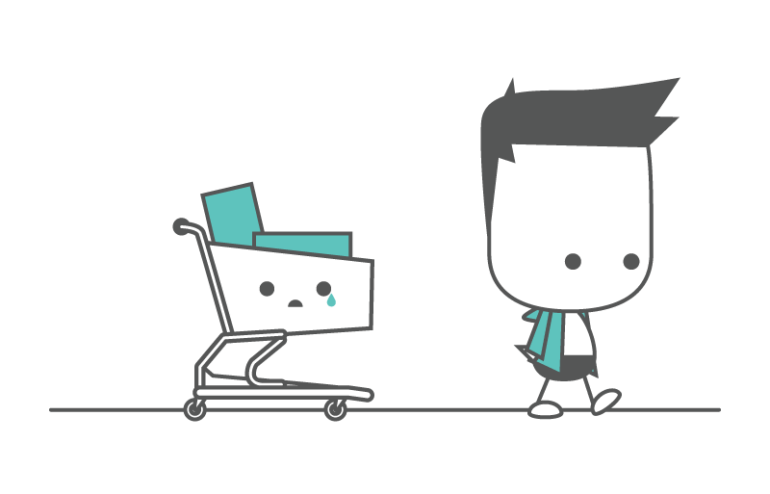Reduce Your Shopping Cart Abandonment Rate
Consider what it would be like if shopping in the real world was the same as shopping online. You enter a supermarket or department store and begin loading your shopping cart, only to be interrupted by a kitten trying to play with a nerf gun in Aisle 3. You quickly forget about what it was you were talking of buying, gaze at the kitten for a few moments, and then exit the shop.
Shopping Cart Abandonment is a term used to describe when a customer abandons a shopping cart. When customers add things to their shopping cart then leave before completing their order, this is known as shopping cart abandonment.The cart abandonment rate is a crucial business indicator for retailers to monitor because it is linked to consumer conversion rates and sales. A high cart abandonment rate is a sign that your purchasing process or behavior is prone to frustration.
And if you don’t think it’s a challenge for your eCommerce shop, you might be surprised at how much revenue you’re losing.Since67.91 percent of all shopping carts are abandoned, this is the case. This suggests that almost two-thirds of people who add items to their shopping cart would abandon them without using their credit card. That’s a lot of money and opportunities wasted. The good news is that you can put a stop to it. And if you took the instructions in this post, you’ll see a decrease in cart abandonment and a rise in sales. According to some surveys, 75% of site visitors who abandoned their carts intended to return to the site to complete their purchase or continue their study. In reality, only 2% of customers convert on their first visit to an ecommerce store, and 92% of first-time visitors have no intention of purchasing anything at that time. In reality, it takes an average of five contacts before a customer agrees to buy from a company.
How To Reduce Cart Abandonment In Online Stores
You’re already familiar with the usual tips and advice if you’ve spent a bit of time learning how to minimize customer acquisition costs. It’s no longer a mystery that abandonment rates are extremely high.
Many articles about cart abandonment, for the most part, show you a variety of ways to change your purchase flow. And, while this is always sound advice, we didn’t want to start from scratch.
- Exit-Intent Popups are a great way to catch people’s attention when they’re about to leave.
Creating a popup that uses Exit-Intent Technology is one of the most effective ways to avoid customer acquisition costs. When a user is actively exiting your checkout page, an exit-intent popup will show your campaign. This implies you can catch the users’ attention just as they’re about to leave their shopping carts.
If you want to minimize cart abandonment, you could use this opportunity to give a coupon code or a special discount to your potential customer. You will encourage reluctant consumers to complete their order by engaging with them at this crucial point in their customer experience. In reality, Shockbyte credits OptinMonster’s departure campaign for 52 percent of its sales while also lowering cart abandonment on its platform. This is an especially effective tactic for online retailers that cater to people who enjoy “window shopping.” An exit-intent popup has the potential to turn casual visitors into long-term customers.
- Reduce the total number of steps in the checkout process.
Customers took 5.08 steps on aggregate to execute a checkout, according to Smashing Magazine’s analysis of the top 100 grossing e-commerce websites in 2012. That’s a lot of people. Otherwise, you risk losing 21% of your future customers by making the checkout process too long. So, if you’re thinking however many measures a great purchasing process must have, the response is as few as possible. Just need the most basic information, such as a person’s name, email and delivery addresses, and form of payment, and never have them fill out a certain data simultaneously.
- Make it easy to navigate between the cart and the store.
Consumers seldom make an order, find and pick it easily and quickly, and check out in a single seamless experience. Shopping online, like shopping in a physical store, can be secondary, inefficient, and non-linear. Customers will be more likely to remain with their carts and checking out if you make life easy for any of them to switch between this and your shop.
Although navigating between a shopping basket and an online store is one of the most efficient ways to reduce friction during the checkout process, it has been one of the most difficult to master.Even the largest ecommerce stores, such as Amazon, are actively experimenting with purchase workflow to fine-tune the shopping experiences and make it easy to purchase more products. Some of the same information in an online standard that represent the rest of your website relate to your purchase pages as well. When it comes to your purchase process, the old web development adage “the Back button does not exist” is particularly true.
- Provide a variety of payment options
You don’t want anything – anything – to get in the way of your customers having a satisfying, fulfilling, and eventually smooth customer experience while designing your ecommerce purchase pages. Nevertheless, if you only have one (or a few) payment options, you’re putting unnecessary barriers in the way of your prospects and sales.
Although credit card payment options are obvious, customers now have more opportunities than it has ever been for paying for products online. PayPal is still going strong (somehow), but digital currencies like Apple Pay and Google Wallet are gaining traction, especially among the young generations.
- Don’t put too much pressure on yourself.
It should not be necessary to register. The majority of people still get a lot of emails and don’t want to be pressured to sign up for yet another one. The most of us have a lot of username and passwords, so creating even another one can be overwhelming. This suggests that identification ought to be voluntary rather than mandatory.
Can you recall at least one instance before you were required to sign up for a postal subscription to purchase something in a traditional brick and mortar store? I’m guessing the answer is “no,” because stuff like this never happen. When people buy a fragrance in Sephora shop, you don’t have to register online for anything.
- Switch on live chat on your website’s pages.
When a customer is about to purchase your product, they are thinking about a lot of things. They might have questions about your product that aren’t addressed on the website. Of course, all of these answers and more could be found on a different list. Your buyer, on the other hand, is unlikely to have the patience to look around. If they can’t answer these questions, they may just go to a competitor’s website.They can, however, make this statement and get their answers in time to make their purchasing decision using live chat functionality. Many resources are available, including Intercom, Acquire.io, FreshWorks, and others.
- Make it easy to save carts.
When you go shopping in a physical store, you either buy something or you don’t. You can either wait in line to pay for whatever is in your cart or leave the store empty-handed. Online shopping, on the other hand, is not as easy. Consumers continue to reap the benefits of online shopping, such as the opportunity to return to an ongoing order – even several times. Make it easy for users to return to abandoned carts to boost conversions.
CONCLUSION
Although each consumer segment is unique, many shoppers share certain purchasing patterns and expectations. One thing is certain: shoppers who have a frustrating and time-consuming checkout experience are more likely to abandon their purchase. Online retailers must continue to promote stellar purchase experiences to turn shoppers into paying customers in tomorrow’s experience-driven environment.




